27 3D Graphics
27 3D 图形
Hi, I'm Carrie Anne, and welcome to Crash Course Computer Science!
嗨,我是 Carrie Anne,欢迎收看计算机科学速成课!
Over the past five episodes,
在过去五集
we've worked up from text-based teletype interfaces to pixelated bitmapped graphics.
我们从基于电传打字机的命令行界面,讲到图形怎么显示到屏幕上
Then, last episode,we covered Graphical User Interfaces and all
再到上集的 图形用户界面(GUI)
their "Ooey Gooey" richness.
以及图形界面的美味
All of these examples have been 2D. But of course "we are living in a 3D world
之前的例子都是2D, 但我们生活的世界是3D的
and I'm a 3 dimensional girl!
我也是个三维 girl~
So today, we're going to talk about some fundamental methods in 3D computer graphics
所以今天,我们讲3D图形的基础知识
and how you render them onto a 2D screen.
以及如何渲染 3D 图形到 2D 屏幕上
As we discussed in episode 24 we can write functions that draw a line between any two points like A and B.
24集中说过,可以写一个函数,从A到B画一条线
By manipulating the X and Y coordinates of points A and B, we can manipulate the line.
通过控制 A 和 B 的(X,Y)坐标,可以控制一条线
In 3D graphics, points have not just two coordinates, but three -X, Y and Z.
在3D图像中, 点的坐标不再是两点, 而是三点, X,Y,Z
Or "zee" but I'm going to say "zed".
或读"Zee",但我之后会读成"Zed"
Of course, we don't have X/Y/Z coordinates on a 2D computer screen
当然,2D的电脑屏幕上,不可能有 XYZ 立体坐标轴
so graphics algorithms are responsible for "flattening" 3D coordinates onto a 2D plane.
所以有图形算法,负责把3D坐标"拍平"显示到2D屏幕上
This process is known as 3D Projection.
这叫"3D投影"
Once all of the points have been converted from 3D to 2D
所有的点都从3D转成2D后
we can use the regular 2D line drawing function to connect the dots… literally.
就可以用画2D线段的函数 来连接这些点
This is called Wireframe Rendering.
这叫 "线框渲染"
Imagine building a cube out of chopsticks, and shining a flashlight on it.
想象用筷子做一个立方体,然后用手电筒照它
The shadow it casts onto your wall its projection is flat.
墙上的影子就是投射,是平的
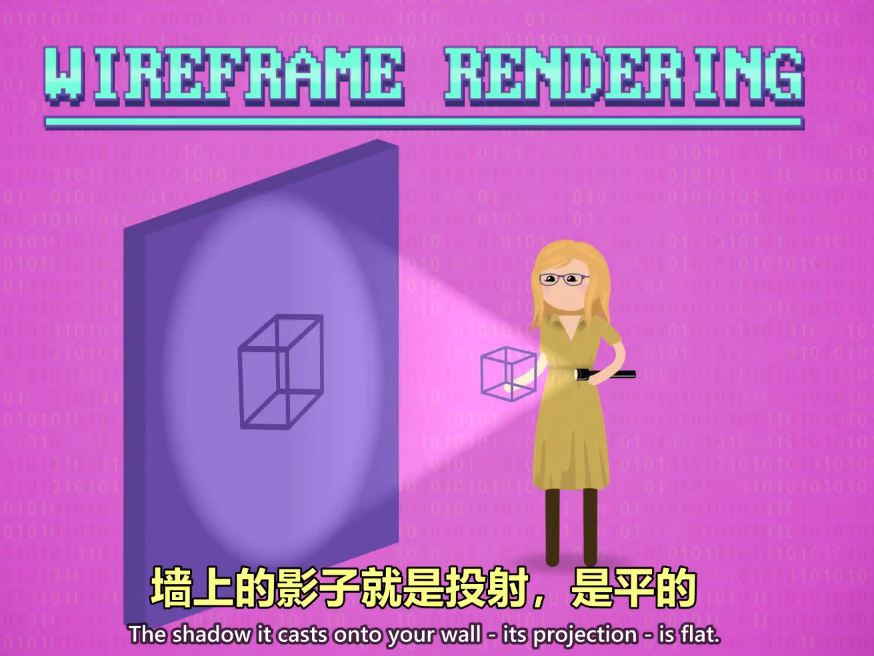
If you rotate the cube around
如果旋转立方体
you can see it's a 3D object, even though it's a flat projection.
投影看起来会像 3D 物体,尽管是投影面是平的
This transformation from 3D to 2D is exactly what your computer is doing
电脑也是这样3D转2D
just with a lot more math… and less chopsticks.
只不过用大量数学,而不是筷子
There are several types of 3D Projection.
3D投影有好几种
What you're seeing right now is an Orthographic Projection
你现在看到的,叫 正交投影
where, for example, the parallel sides in the cube appear as parallel in the projection.
立方体的各个边,在投影中互相平行
In the real 3D world through, parallel lines converge as they get further from the viewer
在真实3D世界中,平行线段会在远处收敛于一点
like a road going to the horizon.
就像远处的马路汇聚到一点
This type of 3D projection is called Perspective Projection .
这叫 透视投射
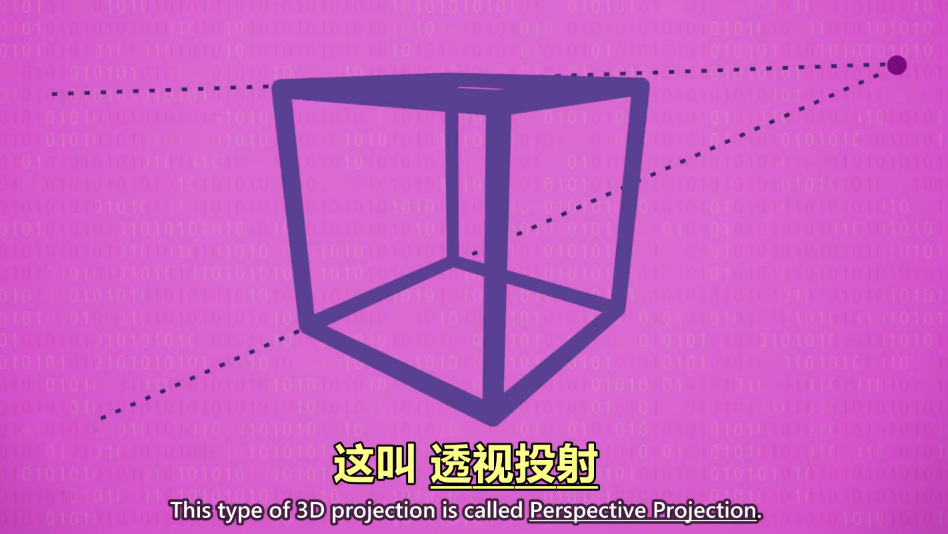
It's the same process, just with different math.
过程是类似的,只是数学稍有不同
Sometimes you want perspective and sometimes you don't --
有时你想要透视投影,有时不想
the choice is up to the developer.
具体取决于开发人员
Simple shapes, like cubes, are easily defined by straight lines.
如果想画立方体这种简单图形,直线就够了
But for more complex shapes, triangles are better
但更复杂的图形,三角形更好
what are called polygons in 3D graphics.
在3D图形学中,我们叫三角形"多边形"(Polygons)
Look at this beautiful teapot made out of polygons.
看看这个多边形组成的 漂亮茶壶
A collection of polygons like this is a mesh
一堆多边形的集合叫 网格
The denser the mesh, the smoother the curves and the finer the details.
网格越密,表面越光滑,细节越多
But, that also increases the polygon count, which means more work for the computer
但意味着更多计算量
Game designers have to carefully balance model fidelity vs. polygon count,
游戏设计者要平衡角色的真实度,和多边形数量
because if the count goes too high
如果数量太多,
the framerate of an animation drops below what users perceive as smooth.
帧率会下降到肉眼可感知,用户会觉得卡
For this reason, there are algorithms for simplifying meshes.
因此有算法用来简化网格
The reason triangles are used,
之所以三角形更常用,
and not squares, or polygons, or some other more complex shape
而不是用正方形,或其它更复杂的图形
is simplicity:
是因为三角形的简单性
three points in space unambiguously define a plane.
空间中 三点定义一个平面
If you give me three points in a 3D space, I can draw a plane through it
如果给3个3D点,我能画出一个平面
there is only one.. single.. answer.
而且只有这一个答案
This isn't guaranteed to be true for shapes with four or more points.
4个或多于4个点就不一定了
Also two points aren't enough to define a plane, only a line,
而2个点不够定义平面,只能定义线段
so three is the perfect and minimal number. Triangles for the win!
所以3是最完美的数字,三角形万岁
Wireframe rendering is cool and all sorta retro but of course 3D graphics can also be filled.
线框渲染 虽然很酷,但3D图像需要填充
The classic algorithm for doing this is called Scanline Rendering,
填充图形的经典算法叫 扫描线渲染 (Scanline Rendering),
first developed in 1967 at the University of Utah
于1967年诞生在犹他州大学
For a simple example, let's consider just one polygon.
为了例子简单,我们只看一个多边形
Our job here is to figure out how this polygon translates to filled pixels on a computer screen
我们要思考,这个多边形如何转成一块填满像素的区域
so let's first overlay a grid of pixels to fill
我们先铺一层像素网格
The scanline algorithm starts by reading the three points that make up the polygon
扫描线算法 先读多边形的3个点
and finding the lowest and highest Y values. It will only consider rows between these two points.
找最大和最小的Y值,只在这两点间工作
Then, the algorithm works down one row at a time.
然后算法从上往下,一次处理一行
In each row, it calculates where a line running through
计算每一行
the center of a row intersects with the side of the polygon.
和多边形相交的2个点
Because polygons are triangles, if you intersect one line, you have to intersect with another.
因为是三角形,如果相交一条边,
It's guaranteed!
必然相交另一条
The job of the scanline algorithm is to fill in the pixels between the two intersections.
扫描线算法 会填满2个相交点之间的像素
Let's see how this works.
来看个具体例子
On the first row we look at we intersect here and here.
第一行 相交于这里和这里
The algorithm then colors in all pixels between those two intersections.
算法把两点间填满颜色
And this just continues, row by row, which is why it's called Scan... Line... Rendering.
然后下一行,再下一行,所以叫 扫描..线..渲染
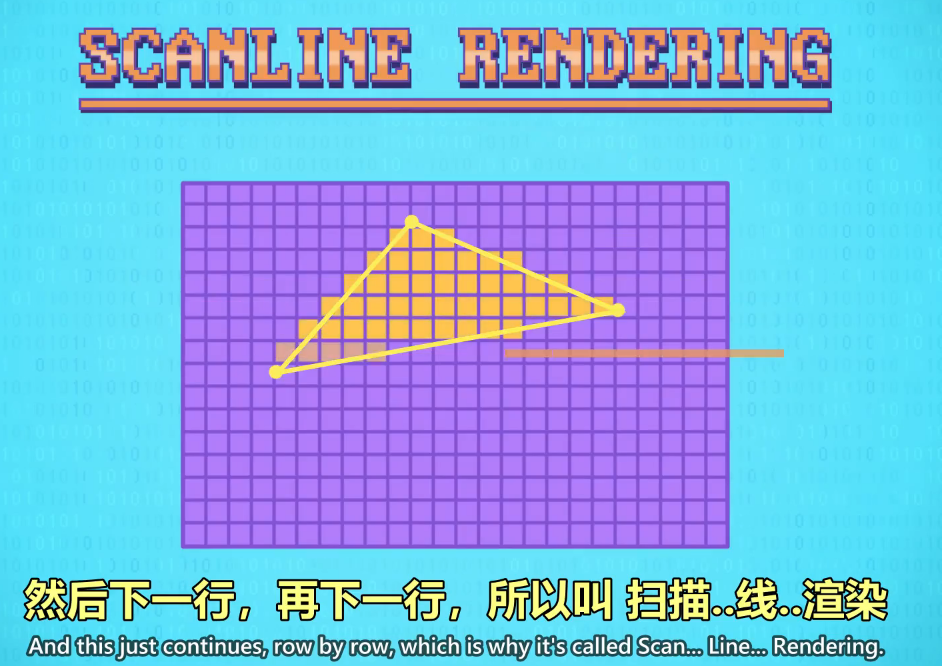
When we hit the bottom of the polygon, we're done.
扫到底部就完成了
The rate at which a computer fills in polygons is called the fillrate.
填充的速度叫 fillrate(填充速率)
Admittedly, this is a pretty ugly filled polygon. It has what are known as "Jaggies" rough edges.
当然 这样的三角形比较丑,边缘满是锯齿
This effect is less pronounced when using smaller pixels.
当像素较小时 就不那么明显
But nonetheless, you see these in games all the time, especially on lower powered platforms.
但尽管如此,你肯定在游戏里见过这种效果,特别是低配电脑
One method to soften this effect is Antialiasing.
一种减轻锯齿的方法叫, 抗锯齿(Antialiasing)
Instead of filling pixels in a polygon with the same color,
与其每个像素都涂成一样的颜色
we can adjust the color based on how much the polygon cuts through each pixel
可以判断多边形切过像素的程度,来调整颜色
If a pixel is entirely inside of a polygon,it gets fully colored.
如果像素在多边形内部,就直接涂颜色
But if the polygon only grazes a pixel, it'll get a lighter shade.
如果多边形划过像素,颜色就浅一些
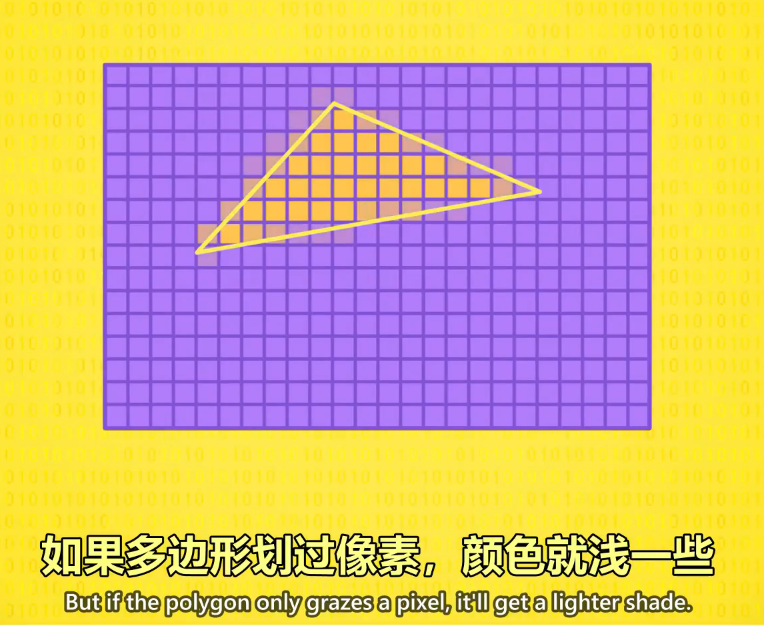
This feathering of the edges is much more pleasant to the eyes.
这种边缘羽化的效果 看着更舒服些
Antialiasing is used all over the place, including in 2D graphics, like fonts and icons.
抗锯齿 被广泛使用,比如字体和图标
If you lean in real close to your monitor..
如果你把脸贴近屏幕
Closer, Closer.
近点..再近点
You'll see all the fonts in your browser are Antialiased. So smooth!
你能看到浏览器里字体是抗锯齿的,超平滑
In a 3D scene, there are polygons that are part objects in the back, near the front,and just about everywhere.
在3D场景中,多边形到处都是
Only some are visible,
但只有一部分能看见
because some objects are hidden behind other objects in the scene
因为其它的被挡住了
what's called occlusion .
这叫 遮挡
The most straightforward way to handle this is to use a sort algorithm,
最直接的处理办法是用排序算法
and arrange all the polygons in the scene from farthest to nearest, then render them in that order.
从远到近排列,然后从远到近渲染
This is called the Painter's Algorithm , because painters also have to start with the background
这叫 画家算法 因为画家也是先画背景
and then increasingly work up to foreground elements.
然后再画更近的东西
Consider this example scene with three overlapping polygons.
看这个例子,有3个重叠的多边形
To make things easier to follow, we're going to color the polygons differently.
为了简单,我们画成不同颜色
Also for simplicity, we'll assume these polygons are all parallel to the screen
同时,假设3个多边形都和屏幕平行
but in a real program, like a game,
但在实际应用中, 比如游戏里,
the polygons can be tilted in 3D space.
多边形可能是倾斜的
Our three polygons, A B and C… are at distance 20, 12 and 14.
3个多边形A,B,C,距离20,12,14
The first thing the Painter's Algorithm does is sort all the polygons, from farthest to nearest.
画家算法的第一件事,是从远到近排序
Now that they're in order, we can use scanline rendering to fill each polygon, one at a time.
现在有序了,我们可以用 扫描线算法 填充多边形,一次填一个
We start with Polygon A, the farthest one away.
我们从最远的A开始
Then we repeat the process for the next farthest polygon, in this case, C.
然后重复这个过程,填充第二远的C
And then we repeat this again, for Polygon B.
然后是 B
Now we're all done, and you can see the ordering is correct. The polygons that are closer, are in front!
现在完成了,可以看到顺序是对的,近的多边形在前面!
An alternative method for handling occlusion is called Z-Buffering .
还有一种方法叫 深度缓冲
It achieves the same output as before, but with a different algorithm.
它和之前的算法做的事情一样,但方法不同
Let's go back to our previous example, before it was sorted.
我们回到之前的例子,回到排序前的状态
That's because this algorithm doesn't need to sort any polygons, which makes it faster.
因为这个算法不用排序,所以速度更快
In short, Z-buffering keeps track of the closest distance
简而言之,Z-buffering 算法会记录
to a polygon for every pixel in the scene.
场景中每个像素和摄像机的距离
It does this by maintaining a Z-Buffer, which is just a matrix of values that sits in memory.
在内存里存一个数字矩阵
At first, every pixel is initialized to infinity.
首先,每个像素的距离被初始化为"无限大"
Then Z-buffering starts with the first polygon in its list. In this case, that's A.
然后 Z-buffering 从列表里第一个多边形开始处理,也就是A
It follows the same logic as the scanline algorithm, but instead of coloring in pixels,
它和扫描线算法逻辑相同,但不是给像素填充颜色
it checks the distance of the polygon versus what's recorded in its Z-Buffer.
而是把多边形的距离,和 Z-Buffer 里的距离进行对比
It records the lower of the two values.
它总是记录更低的值
For our Polygon A, with a distance of 20, it wins against infinity every time.
A距离20,20小于"无限大",所以缓冲区记录20
When it's done with Polygon A, it moves on to the next polygon in its list, and the same thing happens.
算完A之后算下一个,以此类推
Now, because we didn't sort the polygons,
因为没对多边形排序
it's not always the case that later polygons overwrite high values.
所以后处理的多边形并不总会覆盖前面的
In the case of Polygon C,
对于多边形C
only some of the values in the Z-buffer get new minimum distances.
缓冲区里只有一部分值会被多边形C的距离值覆盖
This completed Z-buffer is used in conjunction with a fancier version of scanline rendering
Z缓冲区完成后,会和"扫描线"算法的改进高级版配合使用
that not only tests for line intersection,
不仅可以勘测到线的交叉点
but also does a look up to see if that pixel will even be visible in the final scene.
还可以知道某像素是否在最终场景中可见
If it's not, the algorithm skips it and moves on.
如果不可见,扫描线算法会跳过那个部分
An interesting problem arises when two polygons have the same distance,
当两个多边形距离相同时,会出现一个有趣问题
like if Polygon A and B are both at a distance of 20. Which one do you draw on top?
比如多边形 A 和 B 距离都是 20, 哪个画上面?
Polygons are constantly being shuffled around in memory and changing their access order.
多边形会在内存中移来移去,访问顺序会不断变化
Plus, rounding errors are inherent in floating point computations.
另外,计算浮点数有舍入误差
So, which one gets drawn on top is often unpredictable.
所以哪一个画在上面, 往往是不可预测的
The result is a flickering effect called Z-Fighting, which if you've played 3D games no doubt encountered.
导致出现 Z-fighting 效果,如果你玩过3D游戏,肯定见过
Speaking of glitches, another common optimization in 3D graphics is called Back-Face Culling.
说起 故障,3D游戏中有个优化叫 背面剔除
If you think about it, a triangle has two sides, a front and a back.
你想想,三角形有两面,正面和背面
With something like the head of an avatar, or the ground in a game,
游戏角色的头部或地面,
you should only ever see one side -the side facing outwards.
只能看到朝外的一面
So to save processing time, the back-side of polygons are often ignored in the rendering pipeline
所以为了节省处理时间,会忽略多边形背面
which cuts the number of polygon faces to consider in half.
减了一半多边形面数
This is great, except when there's a bug that lets you get inside of those objects,and look outwards.
这很好,但有个bug是 如果进入模型内部往外看
Then the avatar head or ground becomes invisible.
头部和地面会消失
Moving on. We need to talk about lighting -also known as shading
继续,我们讲灯光,也叫 明暗处理
because if it's a 3D scene, the lighting should vary over the surface of objects.
因为3D场景中, 物体表面应该有明暗变化
Let's go back to our teapot mesh.
我们回到之前的茶壶网格
With scanline rendering coloring in all the polygons, our teapot looks like this.
用"扫描线"算法渲染所有多边形后,茶壶看起来像这样
Not very 3D.
没什么 3D 感
So, let's add some lighting to enhance the realism!
我们来加点灯光,提高真实感
As an example, we'll pick 3 polygons from different parts of our teapot.
为了举例,我们从茶壶上挑3个不同位置的多边形
Unlike our previous examples, we're now going to consider how these polygons are oriented in 3D space
和之前的例子不同,这次要考虑这些多边形面对的方向
they're no longer parallel to the screen, but rather tilted in different 3D directions.
它们不平行于屏幕,而是面对不同方向
The direction they face is called the Surface Normal ,
他们面对的方向叫 " 表面法线 "
and we can visualize that direction with a little 3D arrow that's perpendicular to the polygon's surface.
我们可以用一个垂直于表面的小箭头,来显示这个方向
Now let's add a light source.
现在加个光源
Each polygon is going to be illuminated a different amount. Some will appear brighter
每个多边形被照亮的程度不同 有的更亮
because their angle causes more light to be reflected towards the viewer.
因为面对的角度,导致更多光线反射到观察者
For example, the bottom-most polygon is tilted downwards,
举个例子,底部的多边形向下倾斜
away from the light source, which means it's going to be dark.
远离光源,所以更暗一些
In a similar way, the rightmost polygon is slightly facing away from the light,
类似的,最右的多边形更背对光源
so it will be partially illuminated.
所以只有部分照亮
And finally, there's the upper-left polygon.
最后是左上角的多边形
Its angle means that it will reflect light from the light source towards our view.
因为它面对的角度 意味着会把光线反射到我们这里
So, it'll appear bright.
所以会显得更亮
If we do this for every polygon, our teapot looks like this which is much more realistic!
如果对每个多边形执行同样的步骤,看上去会更真实!
This approach is called Flat Shading, and it's the most basic lighting algorithm.
这叫 平面着色,是最基本的照明算法

Unfortunately, it also makes all those polygon boundaries really noticeable
不幸的是,这使多边形的边界非常明显,
and the mesh doesn't look smooth.
看起来不光滑
For this reason, more advanced lighting algorithms were developed,
因此开发了更多算法
such as Gouraud Shading and Phong Shading .
比如 高洛德着色 和 冯氏着色
Instead of coloring in polygons using just one colour,
不只用一种颜色给整个多边形上色
they vary the colour across the surface in clever ways,
而是以巧妙的方式改变颜色
which results in much nicer output.
得到更好的效果
We also need to talk about textures ,
我们还要说下" 纹理 "
which in graphics refers to the look of a surface,rather than its feel.
纹理在图形学中指外观,而不是手感
Like with lighting, there are many algorithms with all sorts of fancy effects.
就像照明算法一样,纹理也有多种算法,来做各种花哨效果
The simplest is texture mapping .
最简单的是 纹理映射
To visualize this process,let's go back to our single polygon.
为了理解纹理映射,回到单个多边形
When we're filling this in, using scanline rendering,
用"扫描线算法"填充时
we can look up what color to use at every pixel according to a texture image saved in memory.
可以看看内存内的纹理图像 决定像素用什么颜色
To do this, we need a mapping between the polygon's coordinates and the texture's coordinates.
为了做到这点,需要把多边形坐标和纹理坐标对应起来
Let's jump to the first pixel that scanline rendering needs to fill in.
我们来看看"扫描线算法"要填充的第一个像素
The texturing algorithm will consult the texture in memory,
纹理算法会查询纹理
take the average color from the corresponding region, and fill the polygon accordingly.
从相应区域取平均颜色,并填充多边形
This process repeats for all pixels in the polygon, and that's how we get textures.
重复这个过程,就可以获得纹理
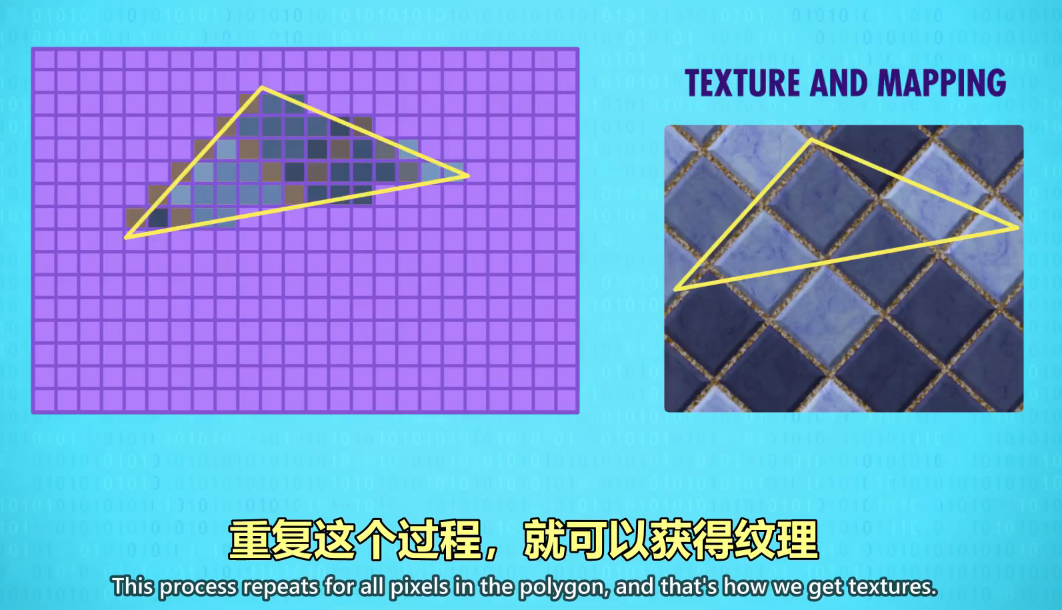
If you combine all the techniques we've talked about this episode, you get a wonderfully funky little teapot.
如果结合这集提到的所有技巧,会得到一个精美的小茶壶
And this teapot can sit in an even bigger scene, comprised of millions of polygons.
这个茶壶可以放进更大的场景里,场景由上百万个多边形组成
Rendering a scene like this takes a fair amount of computation.
渲染这样的场景需要大量计算
But importantly, it's the same type of calculations being performed
但重要的是,再大的场景,过程都是一样的,
over and over and over again for many millions of polygons –
一遍又一遍,处理所有多边形
scanline filling, antialiasing, lighting, and texturing.
扫描线填充, 抗锯齿, 光照, 纹理化
However there are a couple of ways to make this much faster!
然而,有几种方法可以加速渲染
First off, we can speed things up by having special hardware
首先,我们可以为这种特定运算,
with extra bells and whistles just for these specific types of computations, making them lightning fast.
做专门的硬件来加快速度,让运算快如闪电
And secondly,we can divide up a 3D scene into many smaller parts,
其次,我们可以把3D场景分解成多个小部分
and then render all the pieces in parallel,rather than sequentially.
然后并行渲染,而不是按顺序渲染
CPU's aren't designed for this, so they aren't particularly fast.
CPU不是为此设计的,因此图形运算不快
So, computer engineers created special processors just for graphics
所以,计算机工程师为图形做了专门的处理器
a GPU, or Graphics Processing Unit.
叫 GPU "图形处理单元"
These can be found on graphics cards inside of your computer, along with RAM reserved for graphics.
GPU 在显卡上,周围有专用的 RAM
This is where all the meshes and textures live,
所有网格和纹理都在里面
allowing them to be accessed super fast by many different cores of the GPU all at once.
让 GPU 的多个核心可以高速访问
A modern graphics card, like a GeForce GTX 1080 TI,
现代显卡,如 GeForce GTX 1080 TI
contains 3584 processing cores, offering massive parallelization.
有3584个处理核心,提供大规模并行处理
It can process hundreds of millions of polygons every second!
每秒处理上亿个多边形!
Ok, that concludes our whistle stop tour of 3D graphics.
好了,本集对3D图形的介绍到此结束
Next week, we switch topics entirely.
下周我们聊全新的主题
I'll ping you then.
我到时会 ping 你~